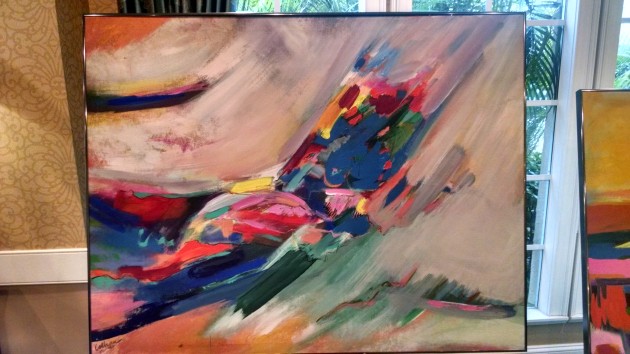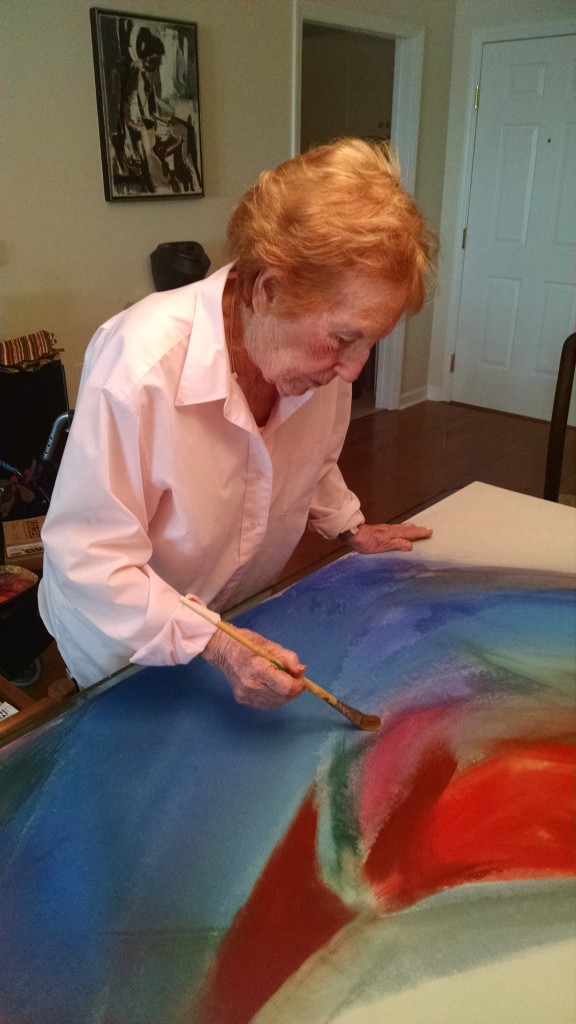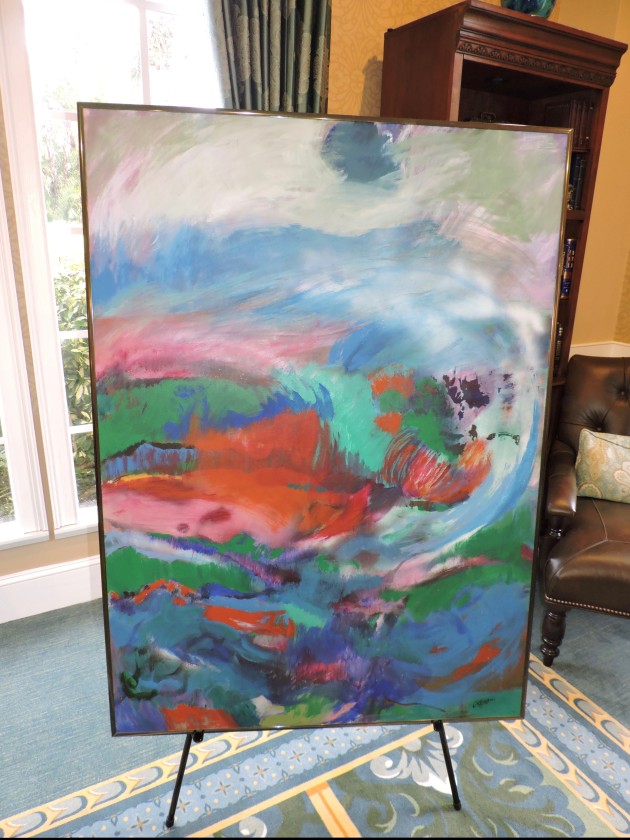
by Lynn Shapiro
Mom’s Show

Painting by Beatrice Colburn
Generic gentility once again anesthetizes the lobby and living room of The Glenridge Senior Living Community, so recently engorged with the vitality of my mother’s raucous art. The tasteful sedation of traditional furnishings harbors no evidence of its weekend transformation.
But echoes of those giant canvases still reverberate in the ether, a hovering memory. It’s not the same, seeing Mom’s paintings back on the walls of her apartment, where we love and recognize them from the internal landscape of our gestation, not nearly so astounding as they were on exhibit in that public space.
My little mom, 95 years old, as quiet and unassuming as ever, and still painting. She never carried her art as an identity badge. But there was always an easel, a canvas in progress, a paint-smeared folding table filled with brushes, empty coffee cans, dozens of squeezed paint tubes, rags, the smell of turpentine and linseed oil. And the paintings covered the walls of our home—abstracted nudes, cubist still lifes, geometrics, botanicals and landscapes, and the massive abstract expressionist panels of color that moved the stationary walls of our lives in a continuum of color. She painted. She sold an occasional piece in galleries and juried shows, but she was always Mom, not The Artist.
When she moved to the Glenridge, she hung as many of them as she could—in the kitchen, the dining area, the living room, the bedroom and den. They transformed her apartment into a garden of color and energy and made her new living quarters a sanctuary, an abode of comfort–private, she thought, like her. We begged her to let us mount a show for her 90th birthday. No, she said, it would be “too much.” Too much of what, she couldn’t say, so we did the next best thing, and surprised her with a retrospective book of her work, secretly photographed and put together by her children and a computer-savvy granddaughter.

Beatrice Colburn is the daughter of Russian Jewish immigrants who scraped together a few sheckles every month to send their artistically precocious kid to The Art Institute of Chicago. She continued art classes there every Saturday throughout grade school and high school, and then went on to a combined program with the University of Chicago and AIC for college.
Arthritis had made it too difficult for her to stand at her giant easel, and she thought she would have to give up painting for good, but The Glenridge had an answer for that with a table easel where she could sit and paint in the art studio of the main building. Eventually, the art committee discovered her quietly turning out small gems of acrylic on paper every Thursday morning. This time, she couldn’t say no.
We bask in the glow of her success. A continuous flow of friends, cousins, neighbors, residents and their guests flooded the space, some on canes, with walkers, in wheel chairs or motorized scooters, some in tennis togs going to or from a match or on their way to play golf, some dressed in sport coats and ties on their way to or from dinner. Throughout the weekend, a buzz of excitement energized the typically hushed social commerce of the space.
Every time the need to go somewhere else, anywhere else, pulled me across the Glenridge lobby and past the living room, the vibrancy of her paintings caught me, spun me around, and pulled me into their wild embrace. I rallied at the thought that these paintings, their colors and movement, urged their life on everyone who entered or exited the sequestered time-warp of The Glenridge.

Painting by Beatrice Colburn

Painting by Beatrice Colburn
Seeing her paintings outside the cocoon of our home, gave them dimensions I had never understood before. The colors—igniting life and movement within my mother that she transferred onto the canvas in the gesture of her brushstroke—speak to my heart, to everything I know to be true and honest and real about the world and about myself. Without my knowing it, they have been my teachers all this time.
I am happy for my mother, and grateful that she could reach such a moment of coalescence, enjoy it in good health with a keen mind, but my gratitude reaches much deeper avenues of thought to a place that is, perhaps, the origin of prayer. For as much as I have loved my mother’s paintings, they have loved me even more, with all the fierceness and fiber of her being. Their timelessness escapes all boundaries in ways that art, like nothing else, rescues us from mortality.
Lynn Shapiro is editor and dance writer for seechicagodance.com. Her fiction, non-fiction, and poetry have been published in Midstream, Jewish Women’s Literary Annual, Realize Magazine, East On Central, Dance Magazine, Chicago Jewish News, and Pioneer Press.
The views and opinions expressed in this article are the author’s own and do not necessarily reflect those of Lilith Magazine.